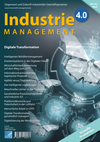Search


Bibtex
Cite as text
@Article{Rieke+Klasen,
Year= "2019",
Number= "4",
Volume= "35",
Pages= "59-62",
Journal = "Industrie 4.0 Management",
Title= "Blockchain-Einsatz zur Optimierung von Produktrückrufen",
Author= "Tobias {Rieke} und André Sardoux {Klasen}",
Doi= "https://doi.org/10.30844/I40M_19-4_S59-62",
Abstract= "Blockchains (BC) werden häufig direkt Bitcoin und andere Kryptowährungen verbunden. Dabei stellt BC die Technologie dar, auf der Bitcoin und Co basieren [1] und sind ein Anwendungsbeispiel unter vielen. Die BC besitzt einige Eigenschaften, die auch für das Supply Chain Management relevant sind. Produktrückrufe nehmen aufgrund der komplexen Supply Chains (SC) immer weiter zu. Dabei liegt die Herausforderung darin, einen Produktrückruf effizient vorzubereiten, durchzuführen und anschließend in die Ursachenanalyse einzusteigen. Genau an dieser Stelle kann die BC-Technologie unterstützen und Transparenz schaffen. So kann eine Reaktion schnell, kosteneffizient und situativ angemessen erfolgen. Ziel des Beitrags ist, einen Einblick in das Potenzial von BC für die Herausforderung „Produktrückruf“ zu geben.",
Keywords= "Blockchain, Supply Chain Management, Produktrückrufe, Lieferkette",
}
Tobias {Rieke} und André Sardoux {Klasen}(2019): Blockchain-Einsatz zur Optimierung von Produktrückrufen. 354(2019), S. 59-62. Online: https://doi.org/10.30844/I40M_19-4_S59-62 (Abgerufen 19.04.24)
Open Access
Abstract
Abstract
Blockchains (BC) werden häufig direkt Bitcoin und andere Kryptowährungen verbunden. Dabei stellt BC die Technologie dar, auf der Bitcoin und Co basieren [1] und sind ein Anwendungsbeispiel unter vielen. Die BC besitzt einige Eigenschaften, die auch für das Supply Chain Management relevant sind. Produktrückrufe nehmen aufgrund der komplexen Supply Chains (SC) immer weiter zu. Dabei liegt die Herausforderung darin, einen Produktrückruf effizient vorzubereiten, durchzuführen und anschließend in die Ursachenanalyse einzusteigen. Genau an dieser Stelle kann die BC-Technologie unterstützen und Transparenz schaffen. So kann eine Reaktion schnell, kosteneffizient und situativ angemessen erfolgen. Ziel des Beitrags ist, einen Einblick in das Potenzial von BC für die Herausforderung „Produktrückruf“ zu geben.
Keywords
Schlüsselwörter
Blockchain, Supply Chain Management, Produktrückrufe, Lieferkette
References
Referenzen
[1] Nakamoto, S.: Bitcoin: Ein elektronisches Peer-to-Peer-Bezahlsystem. URL: www.bitcoin.de/de/bitcoin-whitepaper-deutsch-html, Abrufdatum 15.01.2019.
[2] Chalaemwongwan, N.; Kurutach, W.: State of the art and challenges facing consensus protocols on blockchain. In: The 32nd International Conference on Information Networking (ICOIN 2018) (2018), S. 957–962.
[3] Wüst, Karl; Gervais, Arthur: Do you Need a Blockchain? In: 2018 Crypto Valley Conference, S. 45–54.
[4] Peck, M. E.: Blockchains: How they Work and Why They’ll Change the World. URL: https://spectrum.ieee.org/computing/networks/blockchains-how-they-work-and-why-theyll-change-the-world, Abrufdatum 14.03.2019.
[5] Drescher, D.: Blockchain Grundlagen. Eine Einführung in die elementaren Konzepte in 25 Schritten. 1. Auflage. Frechen 2017.
[6] Arndt, H.: Supply Chain Management. Optimierung logistischer Prozesse. Wiesbaden 2018.
[7] Lehmacher, W.: The global supply chain. How technology and circular thinking transform our future. Cham 2017.
[8] Allianz Global Corporate & Specialty SE: Product Recall. Managing the Impact of the new Risk Landscape. URL: www.agcs.allianz.com/content/dam/onemarketing/agcs/agcs/reports/AGCS-Product-Recall-Report.pdf, Abrufdatum 15.03.2019.
[9] van Venrooy, M.: Produktrückrufe in der deutschen Automobilindustrie. Motivations-, Kommunikations- und Verständnisproblematiken. Wiesbaden 2015.
[10] Institute of Medicine: Improving food safety through a one health approach. Workshop summary. In: National Acad. Press. Washington 2012.
[11] Spiegel Online: Bockshornklee-Samen als Ehec-Verursacher bestätigt. URL: www.spiegel.de/wissenschaft/mensch/epidemie-bockshornklee-samen-als-ehec-verursacher-bestaetigt-a-800671.html, Abrufdatum 12.08.2018.
[12] Strassmann, B.: Gleitmittel fürs Gaspedal. URL: www.zeit.de/2010/07/T-Toyota, Abrufdatum 15.03.2019.
[13] Focus Online: Toyota-Rückruf wird zum Politikum. URL: www.focus.de/auto/news/klemmendes-gaspedal-toyota-rueckruf-wird-zum-politikum_aid_475335.html, Abrufdatum 15.03.2019.
[14] Casey, M. J.; Wong, Pindar: Global Supply Chains are About to Get Better, Thanks to Blockchain. URL: https://hbr.org/2017/03/global-supply-chains-are-about-to-get-better-thanks-to-blockchain, Abrufdatum 10.03.2019.
[15] Europäisches Parlament: Richtlinie 2001/95/EG über die allgemeine Produktsicherheit 2001.
[16] Zhao, X.; Li, Y.; Flynn, B. B.: The financial impact of product recall announcements in China. In: International Journal of Production Economics 142 (2013), S. 115–123.
[17] Glasl, T.; Klindt, T.: Krisenfall Produktrückrufe. Erfolgreiches Management – Recht – Kommunikation. Stuttgart 2012.
[18] Basole, R. C.; Nowak, M.: Assimilation of tracking technology in the supply chain. In: Transportation Research Part E: Logistics and Transportation Review 114 (2018), S. 350–370.
[19] Magno, F.: Managing Product Recalls: The Effects of Time, Responsible vs. Opportunistic Recall Management and Blame on Consumers’ Attitudes. In: Procedia – Social and Behavioral Sciences 58 (2012), S. 1309–1315.
[20] Craig, S. N.; Thomas, R. J.: A strategic approach to managing product recalls. In: Harvard Business Review 74 (5) (1996), S. 102–112.
[21] Edmund, M.: On the Fast Track? In: Quality Progress 51 (2018) 2, S. 10–12.
[22] Tian, F.: A supply chain traceability system for food safety based on HACCP, blockchain & Internet of things. In: The 14th International Conference on Services Systems and Services Management (ICSSSM2017) (2017), S. 16-18.
[23] McDermott, B.: Improving confidence in food safety with IBM Blockchain, URL: www.ibm.com/blogs/blockchain/2017/09/improving-confidence-in-food-safety-with-ibm-blockchain/, Abrufdatum 13.03.2019.
[24] Cai, L.; Pongrace, A.; Butts, Christian; Wang, S.: China’s astounding appetite for Pork. Recent trends and implications for international trade. URL https://publicpolicy.wharton.upenn.edu/live/news/644-chinas-astounding-appetite-for-pork-recent-trends, Abrufdatum 10.03.2019.
[25] del Castillo, M.: Walmart Blockchain Pilot Aims to Make China’s Pork Market Safer. URL: www.coindesk.com/walmart-blockchain-pilot-china-pork-market/, Abrufdatum 10.03.2019.
[26] Higgins, S.: Walmart: Blockchain Food Tracking Test Results Are ‘Very Encouraging’. URL: www.coindesk.com/walmart-blockchain-food-tracking-test-results-encouraging/, Abrufdatum 13.08.2018.
[27] Walmart: In Wake of Romaine E. coli Scare, Walmart Deploys Blockchain to Track Leafy Greens. URL: https://news.walmart.com/2018/09/24/in-wake-of-romaine-e-coli-scare-walmart-deploys-blockchain-to-track-leafy-greens, Abrufdatum 12.03.2019.
[28] Kshetri, N.; Loukoianova, E.: Blockchain Adoption in Supply Chain Networks in Asia. In: IT Prof. 21 (2019) 1, S. 11–15.
[29] Abeyratne, S. A.; Monfared, R. P.: Blockchain Ready Manufacturing Supply Chain using Distributed Ledger. In: IJRET 05 (2016) 9, S. 1–10.
[30] Radocchia, S.: 3 Automotive Consumer Safety Issues Blockchain Will Help Resolve. URL: https://blog.chronicled.com/3-automotive-consumer-safety-issues-blockchain-will-help-resolve-2ae4b0c6ece5, Abrufdatum 13.03.2019.
[31] Werner, H.: Supply Chain Management. Grundlagen, Strategien, Instrumente und Controlling. 6., aktualisierte und überarbeitete Auflage. Wiesbaden 2017.
[32] Weber, Ingo; Xu, Xiwei; Riveret, Régis; Governatori, Guido; Ponomarev, Alexander; Mendling, Jan (2016): Untrusted business process monitoring and execution using blockchain. In: International Conference on Business Process Management.
S. 329–347. [33] Toyoda, Kentaroh; Mathiopoulos, P. Takis; Sasase, Iwao; Ohtsuki, Tomoaki (2017): A Novel Blockchain-Based Product Ownership Management System (POMS) for Anti-Counterfeits in the Post Supply Chain. In: IEEE Access 5, S. 17465–17477.
[34] Kshetri, Nir (2018): 1 Blockchain’s roles in meeting key supply chain management objectives. In: International Journal of Information Management 39, S. 80–89.

 English
English